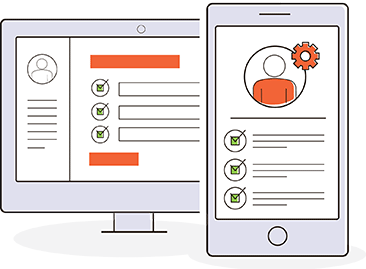Business Process Mapping Software
A Guide to Effective Business Process Mapping

When you're focused on managing an organization, it's often hard to make informed decisions and step back to see that there might be a better way of doing things. When you recognize the negative impacts of keeping a process the same because it's what you're used to, you miss out on opportunities to improve your bottom line. Integrify's business process mapping software helps companies find opportunities to turn their results in a more positive direction.
What is Business Process Mapping?
As dedicated as your workforce may be, it takes more than that to improve your operational efficiency significantly. Even if they can recognize where changes need to happen, it helps to have a process highlighting the opportunities and risks of revamping your workflows. For example, something that may seem to have no impact on one department could bring a lot of fallout to another.
Tools to map business processes are designed to visualize your work processes and procedures as a process diagram. Think of it as a framework that gives you a high-level view of how things function in different areas so staff can make more informed decisions.
You map out the different events involved in each process that affect your final output. Process mapping typically allows users to accomplish this using flowcharts, diagrams, and symbols to organize the sequence of events in a business process visually.
Your result should help answer critical questions that help move events forward, like:
- What are the tasks used to complete the process?
- Who's responsible for completing each task?
- When should you complete each task?
- What prerequisites are needed to get started?
Having a business process map as your blueprint allows you to define each step in a business workflow and better understand all the moving parts. From there, you can start spotting issues and figuring out how to make corrections and avoid them going forward.
Here are some excellent business process mapping examples to review.
Keys to Effective Process Mapping
A few simple rules provide a standardized framework for mapping processes effectively. Of course, you will begin with the scoping hierarchy. Normally, you continuously refine the hierarchy as you proceed through an enterprise process initiative.
Brevity is often seen as the essence of wit. To create a clear process map, precise language and a standard visual syntax of boxes, shapes, colors, and arrows are essential. These elements help to make a process diagram easier to understand.
Follow these simple rules:
A good process diagram uses swim lanes, also known as cross-functional flowcharts. The actor for each step is defined by the lane, not by the action or decision box. The box should contain verb+object phrases.
The arrows on the box imply the to and from the information. They show the originating and ending points.
Right Way: Tight wording, verb+noun, single action in each box
Wrong Way: wordiness, multiple actions in each box, prepositional phrases that are redundant to visual syntax
If the diagram does not use swim lanes, the verbal syntax is Actor+verb+object. The To and From information is still designated visually and does not need to be added verbally to the box. For example:
Other helpful rules for creating good process maps include the following:
- Use boxes for steps and diamonds for decision points.
- Label the exit points from a decision point or logic branch. Phrase these decision points as a question with Yes or No answers whenever possible. For example:
- Is this a new customer?
- Is this a particular order?
- Minimize the number of crossing arrows by carefully placing the boxes on your diagram.
- Keep long arrows tidy by breaking directions in right angles instead of diagonals.
- When there are intricate logical processes with multiple branches, creating separate diagrams for some of the logic branches is advisable. Presenting too much information with numerous decision points on a single diagram can confuse specific audiences.
What are the Benefits of Business Mapping Processes?
 The more precise you are about your business operations, the better prepared you are to develop strategies that help reduce cost, save time, and simplify how things work. However, it's challenging to accomplish that without employees who don't fully understand their role in a work sequence. This can lead to them being out of alignment with an organization's business goals.
The more precise you are about your business operations, the better prepared you are to develop strategies that help reduce cost, save time, and simplify how things work. However, it's challenging to accomplish that without employees who don't fully understand their role in a work sequence. This can lead to them being out of alignment with an organization's business goals.
Mapping out business processes clears that confusion by clarifying everyone within the company, including management and line workers. That cuts down on the potential of mistakes that could impact profits. In addition, mapping can lead to smoother business processes and more efficiency throughout the organization.
Tools like Integrify's business mapping software can help you with the following:
Defining organizational roles
You'd be surprised at how many workers, especially within larger organizations, have difficulty conveying the overall goals of their company or even their department. If your workforce doesn't understand their impact on business processes, employees may come up with their way of doing things, leading to confusion and costly mistakes.
Using process mapping software to create transparent business workflows helps clarify the role everyone plays in specific processes. By establishing visuals that outline what's expected of them, workers better understand the purpose of the work they're tasked with and the importance of each step.
Establishing standardized processes
When you bring new people into your organization, it helps to have effective models that show them how to accomplish their work. Having an optimized business process map makes it easier to train workers on best practices as the basis for completing business functions. Having that uniformity helps set benchmarks for quality to apply across the organization.
Staying compliant
Companies that work in finance and healthcare have specific regulations and compliance responsibilities that they must abide by. Any failure could lead to hefty fines and potential legal action against the organization. There can even be potential work hazards that threaten the welfare of employees.
For that reason, it's crucial to have business process maps in place to ensure that workers consistently comply with standards across the board. They also come in handy as a way of establishing standards on how to handle audits.
How Do You Get Started Mapping Your Processes?

If this is your first time getting into business process mapping, you may feel tempted to try and map out every single business process and create a process diagram for all of them at once. Instead, it's better to pick one as a starting point. That way, you don't have to start from the beginning with every function within your company. Instead, you can use your first process map to move forward with others.
Focus on something critical to your organization that you can put firm metrics around to track. For example, you can look for a process that appears to be underperforming, one that's customer-facing, or one that makes sense strategically to your business goals.
From there, start gathering information about your process, including:
- Each step involved
- Personnel responsible for carrying out the work
- The tasks assigned to everyone
- Who uses the process
- How the process flows
- What triggers changes to the process
While you can use tools as simple as Microsoft Office Visio or an online flowchart tool, you can use Integrify's software to start building workflows that outline your business processes with the option of automating the processes when you're finished building. This can save a great deal of time during the development process. Once you have the details nailed down, you can bring in the team members involved in each activity to help you assemble the final process map.
It's also important to talk with business stakeholders and get their input. That way, you get an accurate picture of the problems they deal with each day versus making assumptions that might turn out to be incorrect.
Once you develop your baseline map, you can start your analysis. Look for gaps and bottlenecks that represent opportunities for improvement. Keep your mind open to all possibilities, including the need to restructure the entire process to improve efficiency and meet company goals.
After putting your changes in place, keep monitoring the functions. Watch for issues that might not have come up before implementation. There may be a need to refine and optimize the process further.
Summary
It is essential that the organization adopt and communicate a common toolset with a single verbal and visual syntax for defining business processes - including process variances as well as the standard daily process flows. This chapter will provide rules and tips to make it easy for individual process teams to coordinate efforts. At this stage of any BPM initiative, it is important to begin flagging the key performance indicators (KPIs) that help an organization understand if process optimization is yielding the desired results.
Interested in Business Defining and Automating Your Processes?
Creating powerful process maps with Integrify's software helps companies transform their operations by maximizing organizational efficiency. Once your processes are mapped, you can quickly turn your map into a live, automated workflow. Check out these helpful resources to learn more about what Integrify can do.

Map and Automate Any Business Process
To see how quickly you can use process mapping to improve operations, request a demonstration or trial of Integrify.

